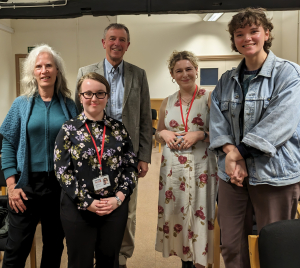In May the trust did something unusual: we moved one of our regular social meetings from Bishop Lloyd’s Palace to the Bluecoat Building. We have to thank Mike, Cathy and Janette for welcoming us there. The changed location was appropriate because Anthony Annakin-Smith was giving his lecture on Chester Foundling Hospital. It was housed in the building.
A group of visitors from the London branch joined us as our guests. They were led by Chris Jones and her Voices Through Time digitalisation team. The Coram Hospital kept detailed records of the children in its care. These date from 1739 to the mid-fifties. There are over half a million documents. The team is digitalising the earliest records. These form about a quarter of the archive. They consist of such items as the registration records of the children. They were numbered on arrival and given a new name. Baptism took place if this was necessary. If the mother left a note this was placed on the record. Medical records are also available. Some of these stories are available on the web
Tony has been working with the group. On a random visit to the Museum, he discovered that a branch of the Hospital had been opened in Chester. This was an interesting surprise to him, and he was driven to research this new information.
Between 1756 and 1760 the government legislated that all children handed in to the Hospital had to be cared for. This period, called the Great Reception, meant that the number of children in the Hospital’s care was multiplied. It was beyond what the London branch could manage, and seven provincial outposts were opened. Chester was one of these. It took orphans from London from 1763 to 1769. The hub of their work was the Bluecoat Building but most children were ‘farmed out’ to so-called nurses in local villages.
There is a synopsis of Tony’s engrossing talk on the Coram website. He is also writing a book on the subject. He hopes it will be published next year. We will keep you informed.
The Foundling Museum in the Euston/Bloomsbury area is well worth a visit. Upstairs are magnificent rooms and an art gallery. Downstairs is a museum telling the sad stories of the young people in its care. Particularly moving is the collection of tokens left by parents to identify their child in case they could ever reclaim them.
FOUNDLING MUSEUM, 40, BRUNSWICK SQUARE, LONDON. WC1N 1AZ. Open Tuesday to Sunday
Karen McKay
